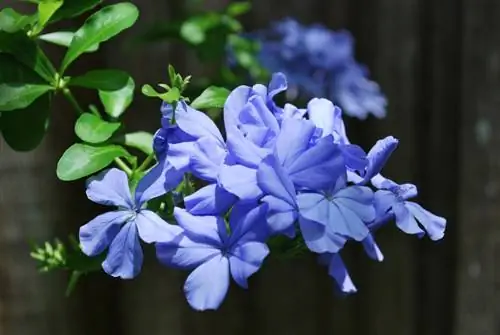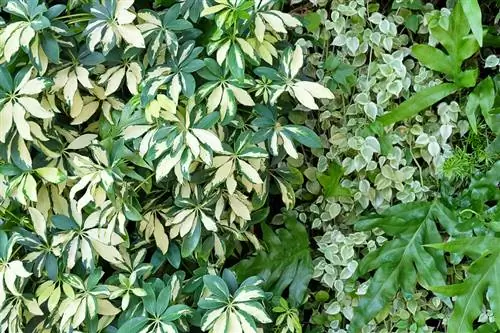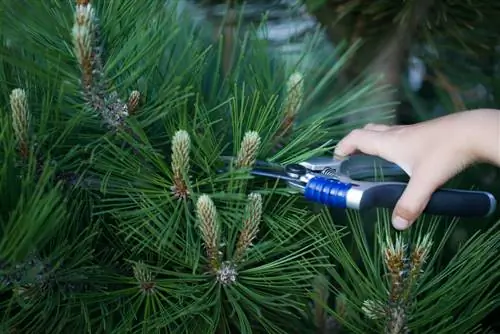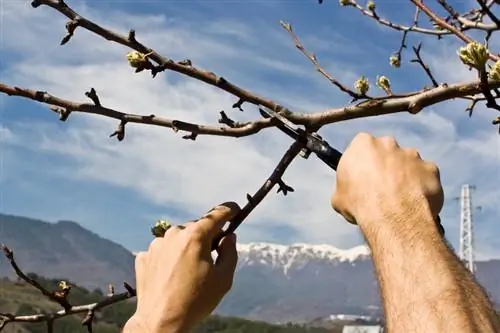- Author admin [email protected].
- Public 2023-12-26 14:17.
- Last modified 2025-01-23 11:21.
Sprawling growth is a good reason to cut the rubber tree. Under the loving care of the gardener, the exotic houseplant thrives in height and width. The slim, compact silhouette with a dense foliage falls by the wayside. This tutorial will familiarize you with all the precautions involved in skilfully pruning Ficus elastica. This is how you prune your rubber tree in an exemplary manner.
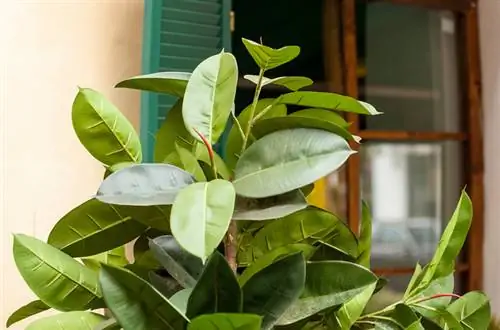
How do I prune my rubber tree correctly?
To properly prune a rubber tree, choose late winter as the ideal time and use sharp bypass pruners. Carry out training, topiary or rejuvenation cuts and protect yourself from the toxic latex.
Best time is in late winter
A rubber tree tolerates pruning at any time of the year. Given its different growth phases, the exotic ornamental tree can best cope with pruning in late winter. In February or March the plant organism is in the transition phase from dormant growth to the beginning of budding. The foliage plant responds particularly well to invasive care measures such as repotting or cutting during this time.
Excursus
Take protective measures in advance against rubber tree sap
Through the floral veins of a rubber tree flows a milky, sticky sap rich in natural rubber and containing significant amounts of allergens and toxins. Before you start cutting, you should protect your skin from the latex, as well as your clothing and floor coverings. Gloves with long cuffs prevent direct skin contact with the secretion and protect you from allergic reactions. Garden aprons or plastic overalls catch plant sap splashes, because the best washing powder will no longer wash natural rubber out of your clothes. Old blankets, tablecloths, curtains or foil protect the floor from irreversible stains.
Sensible cuts
You can promote dense branching with lush leaves on your rubber tree with skillful training pruning. Cutting out the dead wood every few years prevents baldness from the inside out. A rejuvenation cut brings new impetus to the growth of an old, aging rubber tree. The following overview summarizes useful types of cuts:
| Cut style | Goal/Occasion |
|---|---|
| Educational Cut | Structure with densely branched growth |
| Topiary | Adjustment of height and width |
| Rejuvenation cut | revitalize old rubber tree |
If a rubber tree sheds its leaves, this is no reason to prune. Falling leaves on evergreen houseplants is always a signal of inconsistencies in the location or care. Question all basic conditions, such as light, temperature, water and nutrient supply. Once the problems are gone, the decorative leaf plant sprouts again.
Training rubber trees skillfully
The rubber tree is native to the tropical regions between northeast India and Indonesia. In living and working spaces in Central Europe, the exotic ornamental tree is found far away from its homeland. This circumstance is reflected in the fact that Ficus elastica varieties visibly find it difficult to branch densely and luxuriantly. With expert pruning, you can give the rubber tree its floral arms and promote compact growth with many side branches that bear magnificent leaves. This is how it works:
- The best time is in February up to the desired final height
- Cut back a third or half on the middle shoot fromlast year's growth
- Place scissors at a short distance from a leaf or bud (thickening under the bark)
- Stop the flow of juice with a paper handkerchief, old (but clean) cloth or cotton ball
An educational approach makes use of the findings of top-level support. According to this law, woody plants concentrate their growth forces at the tip bud. If you regularly cut back the floral hotspot by a few centimeters, reserve substances will be distributed to deeper buds. You can see the effect on the rubber tree by the strong sprouting of side branches.
Background
Bypass shears handle rubber tree shoots easily
Clean, freshly sharpened bypass scissors should be handy for training and topiary pruning on rubber trees. In contrast to anvil pruners, bypass pruners cut woody shoots smoothly because they are equipped withtwo sharp blades. If you cut your rubber tree with anvil pruners, you have to expect that the shoots will be crushed. The reason for these concerns is the way it works with a sharp blade that presses branches against a blunt opposite side and only then cuts them.
Topiary regulates growth
If a rubber tree shines in all its splendor and desired height at the end of its training phase, the pruning care leads to a topiary. This is doneevery yearor onlyif necessary. How to cut correctly:
- Place the rubber tree at eye level and easily accessible from all sides
- Cover the floor, put on gloves and protect clothing from the milky juice
- Cut back branches that are out of shape
- Reduce height growth by making a cut on the central shoot just above a leaf
- Dab any milky juice flowing out immediately
Topiaries are a good opportunity to clean old, large rubber trees of dead shoots. Removedead wood at the base without damaging the supporting shoot or trunk. Please remember that a leafless shoot is not necessarily dead. To see if there is still life pulsing in the branch, scrape off a little bark. If dry, brown or rotten tissue appears, you can thin out the shoot because no leaves will grow here. Fresh green to cream-colored tissue gives rise to reasonable hope that new leaves will soon sprout here.
In this video, Detlef Römisch clearly explains how to properly cut a rubber tree and how the cuttings can be used for propagation:

Rejuvenate an oversized rubber tree
The legendary growth power of rubber trees is based primarily on their ability to grow vigorously from sleeping eyes. Parallel to the growth in height and width, all Ficus species produce numerous buds that remain dormant. Their only purpose is to replace lost shoots or trunks as quickly as possible. Thanks to this floral masterpiece, you can radically cut back an oversized rubber tree and be assured of renewed growth. How to proceed professionally:
- Clean, disinfect and prepare the bypass pruning shears and folding saw
- First clear out all dead wood
- Saw the middle trunk to the desired height until just above a bud or a leaf
- Cut side branches back to 5 to 10 centimeters, or one to two buds
In addition to the rejuvenation cut, please repot the rubber tree in fresh substrate. Shake off the depleted soil to inspect the root ball. Cut off any dead, stunted root strands before potting the plant. The green plant should regenerate for 8 to 10 days in a partially shaded, warm window seat.
Frequently asked questions
Is a rubber tree poisonous?
A rubber tree is permeated with milky sap. The secretion is sticky and poisonous at the same time. Toxic ingredients cause nausea and vomiting when consumed. Children are particularly at risk because they do not notice the bitter taste of the rubber tree leaves and swallow parts of the plant. Ficus elastica poses a fatal danger to cats, dogs and rodents. Even small pieces of leaf can be a lethal dose if a veterinarian does not take immediate countermeasures. Gardeners with a latex allergy should avoid cultivating Ficus species or only undertake pruning and care work wearing gloves and long-sleeved clothing.
Can the rubber tree go outside on the balcony?
A rubber tree shows its most beautiful side when its leaves are pampered by mild rays of sunshine in a warm, sheltered location. As long as you take into account its extreme sensitivity to cold, your Ficus elastica is in good hands outside. When the temperatures no longer drop below 16 degrees Celsius in spring, you can clear out your rubber tree. In autumn, please clear the plant in good time before the temperature falls below the minimum temperature of 12 degrees Celsius.
Are rubber tree cuttings suitable for propagation from cuttings?
In fact, cut shoots from a rubber tree are far too good for the garbage can or compost heap. Cut a he althy branch to an ideal length of 8 to 10 centimeters. Defoliate the cutting except for the top leaf. Please dab any escaping milky juice with a cloth or cotton ball. Then place the shoot in a glass of soft water in a warm, partially shaded location. Alternatively, place the cutting in a cultivation pot with a mix of potting soil, coconut fiber and sand. Rooting usually takes four to six weeks.
The 3 most common cutting mistakes
If a rubber tree only has leaves on its outer branches or shoots uncontrolled growth, the gardener has made a typical pruning mistake. The same applies to variegated varieties, whose foliage changes from variegated to solid green. The following overview draws attention to the three most common cutting errors, classic damage patterns and provides tips for prevention:
| Cutting errors | malicious image | Prevention |
|---|---|---|
| never photographed | Barbering from the inside out | Remove dead wood every 5 years |
| never cut | expansive growth in all directions | prune shoots that are too long in spring |
| Green wild shoots not removed from variegated varieties | Decline of variegated leaves in exchange for solid green foliage | Promptly thin out wild shoots on variegated rubber trees |
Another common pruning mistake leaves its mark on the floor, on clothing and, in the worst case, on your skin for a long time, because indoor gardeners overlook important preparatory work. We are talking about the milky, sticky plant sap that is riddled with various toxins. Please take the precautions recommended in the tutorial to protect yourself from the latex before attempting the cut.
Tip
Silky, shiny leaves are the most beautiful decoration on the rubber tree. Rub the green or variegated leaves with the insides of banana peels. With this trick you can give the picturesque leaves a lasting shine without having to resort to expensive care sprays. The juicy pulp also has the advantage that it does not clog the leaf pores, but acts as a natural seal against dust.


